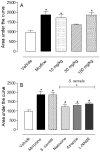Characterization of the Antinociceptive Activity from Stevia serrata Cav
- PMID: 32272558
- PMCID: PMC7235832
- DOI: 10.3390/biomedicines8040079
Characterization of the Antinociceptive Activity from Stevia serrata Cav
Abstract
Background: Stevia serrata Cav. (Asteraceae), widely found in Guatemala, is used to treat gastrointestinal problems. The aim of this study was to demonstrate the antinociceptive and anti-inflammatory effects of the essential oil (EO) and the mechanism of action.
Methods: EO was tested in chemical (capsaicin- and glutamate-induced licking response) or thermal (hot plate) models of nociception at 10, 30 or 100 mg/kg doses. The mechanism of action was evaluated using two receptor antagonists (naloxone, atropine) and an enzyme inhibitor (L-NAME). The anti-hyperalgesic effect was evaluated using carrageenan-induced nociception and evaluated in the hot plate.
Results: All three doses of EO reduced licking response induced by glutamate, and higher doses reduced capsaicin-induced licking. EO also increased area under the curve, similar to the morphine-treated group. The antinociceptive effect induced by EO was reversed by pretreatment of mice with naloxone (1 mg/kg, ip), atropine (1 mg/kg, ip) or L-NAME (3 mg/kg, ip). EO also demonstrated an anti-hyperalgesic effect. The 100 mg/kg dose increased the latency time, even at 1 h after oral administration and this effect has been maintained until the 96th hour, post-administration.
Conclusions: Our data suggest that essential oil of S. serrata presents an antinociceptive effect mediated, at least in part, through activation of opioid, cholinergic and nitrergic pathways.
Keywords: Stevia serrata; antinociception; essential oil; inflammation; pain.
Conflict of interest statement
The authors declare no conflict of interest.
Figures




References
-
- Nash D.L., Williams L.O. Flora of Guatemala. Fieldiana: Botany, Field Mus. Nat. Hist. 1976;24:125–126.
-
- Pruski J.F., Robinson H. Asteraceae Bercht. & J. Presl, nom. cons. (Compositae Giseke, nom. alt.) Flora Mesoam. 2015;5:554–571.
-
- Simas D.L.R., Mérida-Reyes M.S., Muñoz-Wug M.A., Cordeiro M.S., Giorno T.B.S., Taracena E.A., Oliva-Hernández B.E., Martínez-Arévalo J.V., Fernandes P.D., Pérez-Sabino J.F., et al. Chemical composition and evaluation of antinociceptive activity of the essential oil of Stevia serrata Cav. from Guatemala. Nat. Prod. Res. 2017;13:1–3. doi: 10.1080/14786419.2017.1399376. - DOI - PubMed
-
- Adams R.P. Identification of Essential Oil Components by Gas Chromatography/Quadrupole Mass Spectroscopy. Allured Publ. Corp.; Carol Stream, IL, USA: 2001.
Grants and funding
- E-26/202.763/2018/Fundação Carlos Chagas Filho de Amparo à Pesquisa do Estado do Rio de Janeiro
- E-26/010.001837/2015/Fundação Carlos Chagas Filho de Amparo à Pesquisa do Estado do Rio de Janeiro
- 405332/2016/Conselho Nacional de Desenvolvimento Científico e Tecnológico
- 304394/2017-3/Conselho Nacional de Desenvolvimento Científico e Tecnológico
LinkOut - more resources
Full Text Sources

